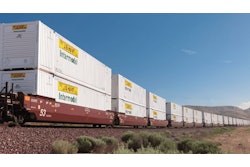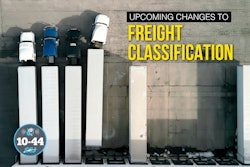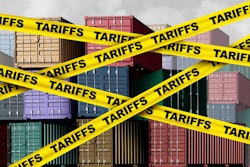The uncertainty on trade policies has affected freight shipments, with the Cass Freight Index for Shipments reporting a 0.4% increase in April over March, but a 3.6% decline in shipment compared to a year ago. Expenditures had a slight increase of 1.2% from last April.
“The trade war is having a variety of effects on freight volumes, with significant decreases likely in May and June in international volumes, but likely a rebound in Q3 due to the recent 90-day U.S./China trade deal,” said Tim Denoyer, the report’s author and ACT Research vice president and senior analyst.
U.S. consumers are still largely buying goods that were imported before tariffs took effect, Denoyer said. However, retailers will soon run out of these. Volumes may also be temporarily bolstered as consumers buy ahead of anticipated price increases.
Following a 13% increase in 2021, and a modest 0.6% rise in 2022, the index saw declines of -5.5% in 2023 and -4.1% in 2024. The trend so far in 2025, according to the report, suggests another year of contraction. Based on seasonal norms, May’s shipments component of the Cass shipments index is projected to fall -1% year-over-year.
April expenditures, which tracks total freight spending, rose 3.3% month-over-month in April. March’s -2% year-over-year decline turned to a positive 1.2% – the first increase in 28 months.
The rebound was driven by freight rates, the report noted, as shipments fell -3.6% in April. The report estimated that rates climbed 5.1% year-over-year.
After surging 38% in 2021, and rising another 23% in 2022, total freight spending dropped -23% in 2023 and fell another -11% in 2024.
Meanwhile, economic activity in the manufacturing sector fell for the third consecutive month in May, following a two-month expansion that was preceded by 26 straight months of contraction, according to the Manufacturing ISM Report On Business. The May PMI registered at 48.5 (a reading of 50 or higher signals growth), down 0.2% from April’s 48.7.
Imports fell sharply to their lowest level in 16 years, down 7.2%, while exports slipped to a five-year low with a -3.0% decline.
Tariffs and broader economic uncertainty remained dominant concerns in the latest ISM survey. Manufacturing executives emphasized that meaningful recovery won’t occur until trade disputes are resolved and tariff policies from the White House are clarified.
“There is continued softening of demand in the commercial vehicle market, primarily related to higher prices and economic uncertainty,” a transportation equipment executive respondent told ISM. “The impact of ever-changing trade policies of the current administration has wreaked havoc on suppliers’ ability to react and remain profitable. Vehicle manufacturers have already rolled price increases into their products to protect their bottom lines but have not been as cooperative with their supply bases. This has resulted in a high occurrence of suppliers falling into financial distress.”
Another executive told ISM that tariffs, avian influenza, and broader commodity markets continue to impact business conditions and add volatility to business planning.
"Tariff whiplash continues while the easing of tariff rates between the U.S., and China in May was welcome news, the question is what happens in 90 days,” said a manufacturing executive. “We are doing extensive work to make contingency plans, which is hugely distracting from strategic work, plus it is also very hard to know what plans we should actually implement. The 10% tariff on other countries is impactful as well, and it is unclear if/when deals will be made."
New orders continue to decelerate, largely due to ongoing negotiations over who will absorb the cost of tariffs between buyers and sellers, said Susan Spence, chair of the ISM Manufacturing Business Survey Committee. Weaker demand from international customers is also playing a role in the slowdown.
The report also noted that companies are actively cutting head count through layoffs, hiring freezes and attrition. Comments from survey participants showed a roughly 1-to-1.4 ratio of hiring to reductions, pointing to an acceleration in workforce cuts. Layoffs were the primary measure, Spence said.
Pricing pressures have also intensified, according to the report. The Prices index has risen by 19.1% points over the last six months, driven largely by increases in steel and aluminum, as well as the widespread 10% tariff on many imported products, Spence said. In May, 45% of respondents reported higher input prices, slightly down from April’s 49%, though still significantly up from just 12.2% from November 2024.
Looking at the Texas Manufacturing Outlook survey, Jason Miller, associate professor of supply chain management at Michigan State University and interim chair of the Department of Supply Chain Management, pointed out that the tariffs are having a mix of effects. The first is positive: an increased domestic demand that some firms see. The rest is negative, such as raising input costs, reducing exports, and triggering pauses due to uncertainty.
“This last effect cannot be understated: the constant changing of the tariff landscape is causing firms to hit the pause button, which isn’t good for economic growth,” Miller said.
Looking ahead, Hamish Woodrow, director of strategic analytics at Motive, observed that business leaders are experiencing decision fatigue as they grapple with the pace of ongoing policy changes and are increasingly reluctant to make significant moves without a clearer roadmap.
Matt Muenster, chief economist at Breakthrough, added that increased market clarity would give companies more confidence to commit to capital investments, which in turn would bolster freight volumes tied to machinery and building supplies.
“While few expect a return to prior tariff levels, continued volatility could start to drag on broader economic confidence, which could pose downside risk to freight demand by year-end,” Woodrow said.













